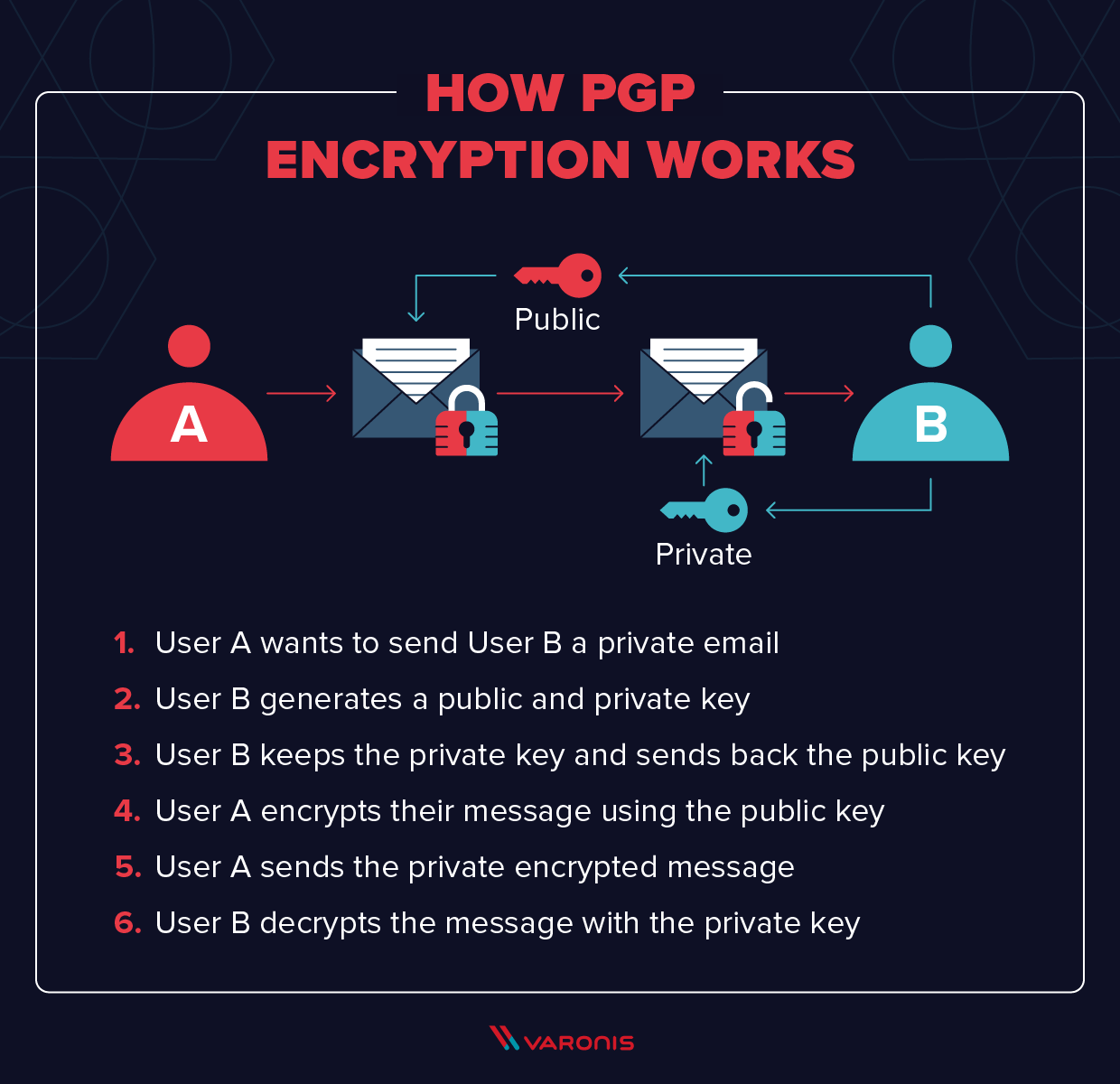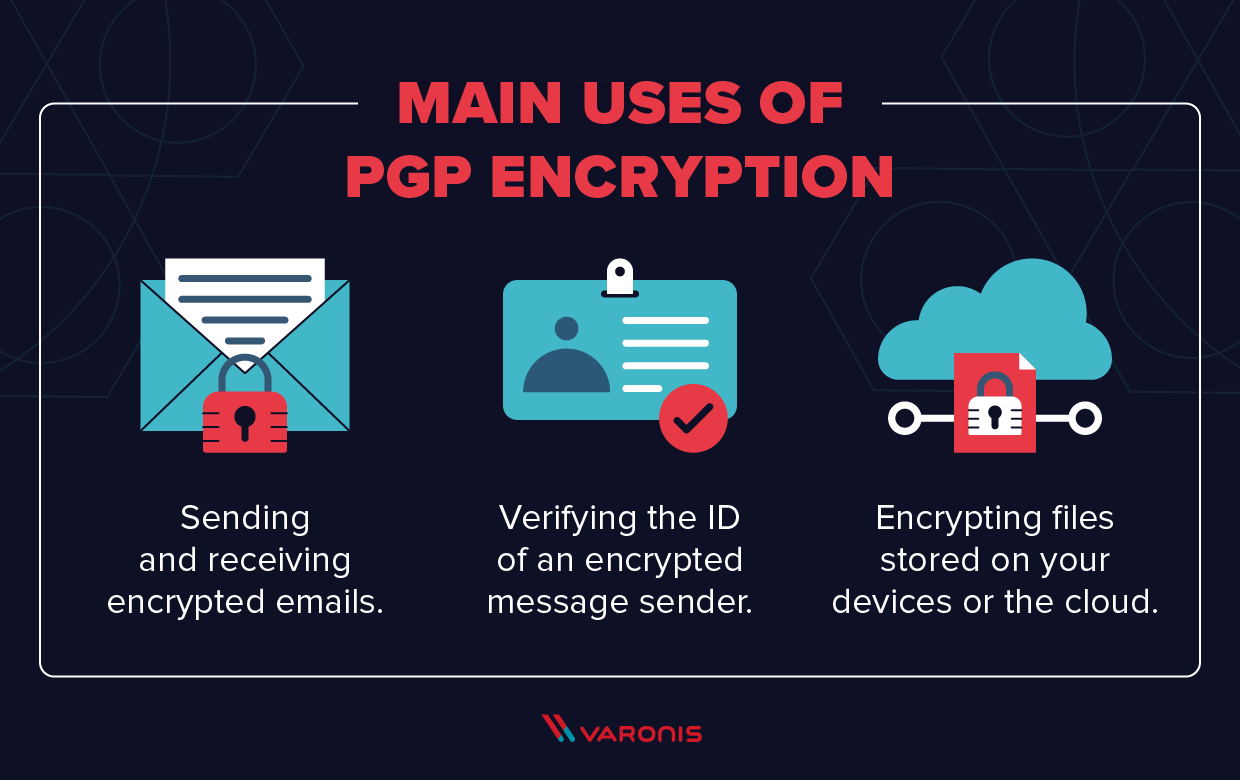Pretty Good Privacy (PGP) is an encryption system used for both sending encrypted emails and encrypting sensitive files. Since its invention back in 1991, PGP has become the de facto standard for email security.
The popularity of PGP is based on two factors. The first is that the system was originally available as freeware, and so spread rapidly among users who wanted an extra level of security for their email messages. The second is that since PGP uses both symmetric encryption and public-key encryption, it allows users who have never met to send encrypted messages to each other without exchanging private encryption keys.
If you want to improve the security of your email messages, PGP offers a relatively easy and cost-effective way to do this. In this guide, we’ll show you how.
How Does PGP Encryption Work?
PGP shares some features with other encryption systems you may have heard of, like Kerberos encryption (which is used to authenticate network users) and SSL encryption (which is used to secure websites).
At a basic level, PGP encryption uses a combination of two forms of encryption: symmetric key encryption, and public-key encryption.
In order to understand how PGP works, it’s useful to look at a diagram:
The mathematics behind encryption can get pretty complex (though you can take a look at the math if you like), so here we’ll stick to the basic concepts. At the highest level, this is how PGP encryption works:
- First, PGP generates a random session key using one of two (main) algorithms. This key is a huge number that cannot be guessed, and is only used once.
- Next, this session key is encrypted. This is done using the public key of the intended recipient of the message. The public key is tied to a particular person’s identity, and anyone can use it to send them a message.
- The sender sends their encrypted PGP session key to the recipient, and they are able to decrypt it using their private key. Using this session key, the recipient is now able to decrypt the actual message.
This might seem like a strange way to do things. Why would we encrypt the encryption key itself?
Well, the answer is pretty simple. Public key cryptography is much, much slower than symmetric encryption (where both the sender and recipient have the same key). Using symmetric encryption requires, though, that a sender share the encryption key with the recipient in plain text, and this would be insecure. So by encrypting the symmetric key using the (asymmetric) public-key system, PGP combines the efficiency of symmetric encryption with the security of public-key cryptography.
Example of PGP Encryption in Action
In practice, sending a message encrypted with PGP is simpler than the above explanation makes it sound. Let’s take a look at ProtonMail – as an example.
ProtonMail natively supports PGP, and all you have to do to encrypt your email is to select Sign Mail. You will see a padlock icon on the subject line of their emails. The email will look like this (the email addresses have been blurred for privacy reasons):
ProtonMail – like most email clients that offer PGP – hides all of the complexity of the encryption and decryption of the message. If you are communicating to users outside of ProtonMail, you need to send them your public key first.
And so, although the message was sent securely, the recipient does not have to worry about the complexities of how this was done.
PGP Encryption Uses
There are, essentially, three main uses of PGP:
- Sending and receiving encrypted emails.
- Verifying the identity of the person who has sent you this message.
- Encrypting files stored on your devices or in the cloud.
Of these three uses, the first – sending secure email – is by far the dominant application of PGP. But let’s take a brief look at all three
Encrypting Emails
As in the example above, most people use PGP to send encrypted emails. In the early years of PGP, it was mainly used by activists, journalists, and other people who deal with sensitive information. The PGP system was originally designed, in fact, by a peace and political activist named Phil Zimmermann, who recently joined Startpage, one of the most popular private search engines.
Today, the popularity of PGP has grown significantly. As more users have realized just how much information corporations and their governments are collecting on them, huge numbers of people now use the standard to keep their private information private.
Digital Signature Verification
A related use of PGP is that it can be used for email verification. If a journalist is unsure about the identity of a person sending them a message, for instance, they can use a Digital Signature alongside PGP to verify this.
Digital signatures work by using an algorithm to combine the sender’s key with the data they are sending. This generates a “hash function,” another algorithm that can convert a message to a block of data of fixed size. This is then encrypted using the sender’s private key.
The recipient of the message can then decrypt this data using the sender’s public key. If even one character of the message has been changed in transit, the recipient will know. This can indicate either the sender is not who they say they are, that they have tried to fake a Digital Signature, or that the message has been tampered with.
Security beyond encryption
PGP is great for small tasks but to protect a network of data you need more. Varonis helps organizations secure their data across file servers, SaaS apps and source control systems. Find out more now.
Encrypting Files
A third use of PGP is to encrypt files. Because the algorithm used by PGP – normally the RSA algorithm – is essentially unbreakable, PGP offers a highly secure way of encrypting files at rest, especially when used alongside a Threat Detection and Response Solution. In fact, this algorithm is so secure that it has even been used in high-profile malware such as the CryptoLocker malware.
Back in 2010, Symantec acquired PGP Corp., which held the rights for the PGP system. Since then, Symantec has become the dominant vendor of PGP file-encryption software through such products as Symantec Encryption Desktop and Symantec Encryption Desktop Storage. This software offers PGP encryption for all your files, whilst also hiding the complexities of encryption and decryption processes.
Do I Need Pretty Good Privacy Encryption?
Whether you need to use PGP encryption will depend on how secure you want your communications (or files) to be. As with any privacy or security software, using PGP requires that you do a little more work when sending and receiving messages, but can also dramatically improve the resilience of your systems to attack.
Let’s take a closer look.
Pros of PGP Encryption
The major pro of PGP encryption is that it is essentially unbreakable. That’s why it is still used by journalists and activists, and why it is often regarded as the best way of improving cloud security. In short, it is essentially impossible for anyone – be they a hacker or even the NSA – to break PGP encryption.
Though there have been some news stories that point out security flaws in some implementations of PGP, such as the Efail vulnerability, it’s important to recognize that PGP itself is still very secure.
Cons of PGP Encryption
The biggest con of PGP encryption is that it is not that user-friendly. This is changing – thanks to off-the-shelf solutions that we will come to shortly – but using PGP can add significant extra work and time to your daily schedule. In addition, those using the system need to be aware of how it works, in case they introduce security holes by using it incorrectly. This means that businesses considering a move to PGP will need to provide training.
For that reason, many businesses might want to consider alternatives. There are encrypted messaging apps like Signal, for instance, that offer encryption that is more straightforward to use. In terms of storing data, anonymisation can be a good alternative to encryption and can be a more efficient use of resources.
Finally, you should be aware that PGP encrypts your messages, but it doesn’t make you anonymous. Unlike anonymous browsers using proxy servers or working through a VPN to hide your true location, emails sent through PGP can be traced to a sender and recipient. Their subject lines are not encrypted either, so you shouldn’t put any sensitive information there.
How Do I Set Up PGP Encryption?
In the vast majority of cases, setting up PGP encryption involves downloading an add-on for your email program, and then following the installation instructions. There are add-ons like this available for Thunderbird, Outlook, and Apple Mail, and we will describe these below. In recent years we have also seen the emergence of a number of online email systems that include PGP by default (the most famous being ProtonMail).
For those of you looking to use PGP to encrypt your files, there are a number of large-scale software solutions available. Symantec, for example, offers PGP-based products such as Symantec File Share Encryption for encrypting files shared across a network and Symantec Endpoint Encryption for full disk encryption on desktops, mobile devices and removable storage.
PGP Encryption Software
If you are looking to start using PGP encryption, this will normally involve downloading a piece of software that automates the process of encryption and decryption. There are a number of different products available to do this, but you should be aware of what to look for.
How to Select PGP Software
- Your primary reason for using PGP is to ensure the security of your messages. When looking for PGP software, therefore, security should be your first concern. Though PGP itself is unbreakable, there have been instances where specific implementations have been compromised. Unless you are an experienced coder, spotting these vulnerabilities is essentially impossible, and so the best solution is to check for any reported vulnerabilities in the software you are considering.
- Beyond this, choosing PGP software comes down to your personal (or business) needs. It’s unlikely, for instance, that you need to encrypt every email you send, and so downloading an add-on for your day-to-day email client might be overkill. Instead, consider using an online PGP service to send important emails.
- Finally, choose a software provider who also provides dedicated support, either through a customer support team or a user community. Learning to use PGP can often come with frustrations as you first navigate the system, and you’re likely to need help at this stage.
Different PGP Solutions
Depending on why you are using PGP, and how often you need to use it, there are several different approaches to setting it up. In this section we will focus on what most users will need from PGP – secure email – rather than encrypted file storage, which is a more complex issue. Here, then, are five solutions for implementing PGP on your home or business networks.
1. Outlook with gpg4o
Gpg4o is one of the most popular PGP solutions for Windows users and aims to integrate seamlessly with Outlook 2010 – 2016.
- Pros: Gpg4o offers simple handling for emails, and integrates well with Outlook. For most Windows users, it offers the easiest and most user-friendly PGP add-on out there.
- Cons: Though Gpg4o is built around the OpenPGP standard, which is open-source and available for scrutiny, the add-on itself is proprietary. In addition, a business license for the add-on is relatively expensive at €56.36, though for this price you also get dedicated support.
2. Apple Mail With GPGTools
The standard implementation of PGP encryption for Mac users is GPGTools, which is a suite of software that offers encryption for all areas of your Mac system.
- Pros: GPGTools integrates well with Apple Mail, as in the example above. It also offers a key manager, software that allows you to use PGP in almost any application, and a tool that allows you to use the command line for the most common key management tasks.
- Cons: Though GPGTools offers the easiest way for Mac users to start using PGP encryption, using this encryption for your primary email can slow the performance of Apple Mail.
3. Thunderbird With Enigmail
As with the tools above, Enigmail was designed to integrate with a specific email client, in this case, Thunderbird.
- Pros: Enigmail has a few key advantages. The first is that, like Thunderbird, the add-on is platform-independent. Secondly, the add-on is completely open-source and is provided for free. It is also regularly updated, and the development team is quick to respond to identified instances of malware.
- Cons: As with most open-source software, Enigmail doesn’t provide dedicated support. On the other hand, the user community is large and active and has compiled a huge amount of reference materials to help you get started.
4. ProtonMail
ProtonMail was one of the first secure email providers and remains one of the most popular. Unlike the solutions above, ProtonMail operates through a web portal, meaning that it is easily separable from your everyday inbox.
- Pros: ProtonMail automatically uses PGP encryption for messages sent between two users of its service, which takes most of the complexity out of setting up and using PGP. Services like this – Hushmail and Mailfence are similar – and are an easy way of sending the occasional encrypted email without re-setting your entire system.
- Cons: Because ProtonMail implements PGP through JavaScript embedded in a website, some people don’t regard it as completely secure. That said, ProtonMail takes the security of their system very seriously, and have been extremely active in improving it.
5. Android and FairEmail
Lastly is FairEmail, which extends PGP encryption to Android phones. This is a stand-alone email app that is free to use.
- Pros: FairEmail is the simplest solution around for users who want to use PGP encryption on their Android phone. It gives you the option of encrypting messages, rather than doing this by default, so you can choose what to encrypt.
- Cons: Because usage of PGP through Android is still quite rare, the user community for FairEmail is quite small.
Pretty Good Privacy FAQ
Even after the explanation above, you may still have some questions. Here are the answers to the most commonly asked questions about PGP.
Q: Is PGP encryption secure?
A: Yes. Though PGP is now more than 20 years old, there have been no vulnerabilities found in the basic implementation of the system. That said, encrypting your emails is not sufficient for total security, and you should always use PGP in combination with a full cybersecurity suite that includes threat detection software.
Q: How does PGP encryption work?
A: PGP uses a combination of symmetric and public-key cryptography to provide users with a secure way to send messages to each other.
Q: What is the best PGP software?
A: The “best” PGP software will depend on your needs. Most people don’t need to encrypt all of their emails, and so for most people a web-based PGP email provider will be the best solution. That said, if you are frequently sending emails that need to be encrypted, you can consider downloading a PGP add-on for your standard email client.
Q: Do I need encryption software?
A: It depends. If you are storing customer information, the answer is yes. Encrypting your personal files is not a necessity, but can dramatically improve your defenses against a cyberattack. Encryption software based on PGP is generally some of the easiest to work with, and is a good place to start when it comes to encrypting your files.
PGP encryption can be a powerful tool in protecting your data, your privacy, and your security. It provides you with a relatively easy, completely secure method of sending emails, and also allows you to verify the identity of the people you are communicating with. Because PGP add-ons are also available for most major email clients, this form of encryption is generally easy to implement.
All this said, secure email is only one aspect of cybersecurity. You should ensure that, in addition to PGP, you also use a robust data security platform and Data Loss Prevention software. Making use of as wide a range of tools as possible is the best way to ensure your privacy and security.
What should I do now?
Below are three ways you can continue your journey to reduce data risk at your company:
Schedule a demo with us to see Varonis in action. We'll personalize the session to your org's data security needs and answer any questions.
See a sample of our Data Risk Assessment and learn the risks that could be lingering in your environment. Varonis' DRA is completely free and offers a clear path to automated remediation.
Follow us on LinkedIn, YouTube, and X (Twitter) for bite-sized insights on all things data security, including DSPM, threat detection, AI security, and more.














